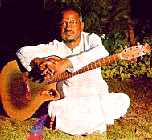 Illayaraja is perhaps unparalled in his vast musical knowledge amongst all time
film music composers. He made his entry, after a long frustrating wait,
with the sensational hit `MachchAnapp pAththeenGalA' in AnnakkiLi.
Widely welcomed as a fresh air of the native music, the song in fact, was
set in western chords for guitar. This song subsequently changed the
entire perspective of the film industry which made Gopichettipalayam as
more favourable shooting ground than Kodambakkam.
Illayaraja is perhaps unparalled in his vast musical knowledge amongst all time
film music composers. He made his entry, after a long frustrating wait,
with the sensational hit `MachchAnapp pAththeenGalA' in AnnakkiLi.
Widely welcomed as a fresh air of the native music, the song in fact, was
set in western chords for guitar. This song subsequently changed the
entire perspective of the film industry which made Gopichettipalayam as
more favourable shooting ground than Kodambakkam.He followed it with a string of hits, including `BadhrakALi', `Chittukkuruvi', `Kavikkuyil', etc. His showmanship reached its pinnacle with the famous, `nAnE nAnA, yArO thAnA' and the songs of ILamai OONjal AdukiRathu'. But that was later proved only to be the glimpse of his talent.
More to follow later years include, `Priya', `SakalakalA vallavan', `payaNaNGaL mudivathillai', `nizhalgaL', `mundhAnai mudicchu' `Mudal mariyathai' `Sindhu bhairavi', (We give it up here). The success was not only in terms of numbers; he did valuable contribution by spotting talents and nurturing them at the right moment. He developed an excellent symbiosis with the versatile genius S.P. Balasubramaniam. He made the right use of Yesudoss and S. Janaki, among the other veterans. He surfaced the talents of SPB Shailaja, Jensi, Deepan Chakravarthy, Chitra, Mano and Swarnalatha. He also had an invaluable assistant in V. Narashimhan, who was also the conductor of Madras Chamber Orchestra. The competition from another doyen M.S. ViswanAthan was faced with ease and helped in blossoming the golden days of tamil film music. They, however, had (and have) mutual respect, which subsequently enabled them to work in joint projects, more to the benefit of the audience.
The talent was to transcend beyond the language barrier. Raja made sensation in Telugu films with such hits like SAGara saNGamA, Swathi Muktyam, Jegadhega veerudu Adhiloka sundari , Bobbili rAja, DharmakshEtram, etc. He also made an attempt to woo larger indian audience with his hindi score in Sadhma, who however preferred ghost-releases of his tamil and telugu hits by Anand-Milind.
His multi-faceted musical genius could do, but to develop excellent association with classical musicians like BAlamuraLi krishnA (Chinnak kaNNan azhaikkiRAn) and T.V. Gopalakrishnan (Andhimazhaip pozhikiRathu). He also had beneficial associations with the Jazz musician Paul Mariot, who influenced his experimental albums like `How to name it' and `Nothing but wind' (the latter of the two incidentally was recorded with the Hindhusthani musician Hariprasad Chourasia on flute). He orchesterized some of the ThiagarAjar krithis and conducted them to the praise of the octagenerian carnatic doyen Sri ChemmaNGudi sreenivAsa iyer. He has composed few kritis on uncommon Carnatic ragas like Ragavardhini, Rukmanbari, etc. Mandolin. U. Srinivas has played these kritis and his rendering is available on a pre-recorded cassette titled "Ilaiyaraja's Classicals". The zenith of his career, arguably, was the moment he recorded his own symphony, conducting the Royal Philharmonic Orchestra of London. (Incidentally, he is the first asian to have his symphony performed by RPH). The long awaited release of the symphony, is expected to be for a wider audience (worldwide, and aptly so).
He has left his indelible impression in the indian music scence (not just in film music alone) and continues to re-normalize his own standrads. Any of the future talent has to evaluated only in comparison.